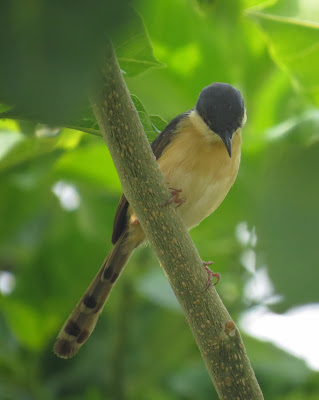ASHY PRINIA
On 2nd May, earlier this year I took part in our democratic process for the first time in my life as I voted in the 2013 elections to the Karnataka state legislative assembly. After having closely followed the developments in the Indian political scenario since 2003, it felt good to exercise what I believe is the greatest right guaranteed by our Constitution. I went to cast my vote at about 1 pm at a government school in my locality and was back within half an hour. As I was killing time later that afternoon, I was distracted by sounds of zeet-zeet-zeet coming from the bushes in the neighboring plot. There was no doubt that it was Ashy Prinia - a common yet shy passerine avain that had avoid my lens for quite some time now. Having nothing else to do, I took my Cannon SX50HS and was lucky enough to get some close shots of this individual.
Scientifically known as Prinia socialis, there are four different sub species of these birds which are endemic to the Indian sub-continent, differentiated mainly by their shades. The sub-species stewartii is found in the northern parts of the country, from the Indus to the Vindhyas; inglisi is common in Bengal and other parts of eastern India whereas P. s. socialis is found in the peninsula. The Lankan sub-species is brevicauda. In the countryside, they are spotted in open grasslands and woodlands. In the cities, they are common in gardens too. Identifying these little creatures is extremely easy. In fact, one can rely on the following features - their small size; their grayish feathers and white underside; the upright tail and more than anything else, that characteristic call of tchup-tchup-tchup or zeet-zeet-zeet that they make. They are insectivorous.
A unique feature about these birds is that they shed their feathers twice a year - a process known as Moulting which is rare even amongst warblers. Presently classified as Least Concern by the IUCN, Ashy Prinia or the Ashy Wren-Warbler is considered to be doing well for the time being. However, the loss of suitable habitat in the country to satisfy the needs of our ever-growing population remains a cause of concern. Meanwhile, photographing these little ones can be a bit of a challenge. Considering their small size, their main form of defense, like most of the birds is by fleeing from the scene to a safer place. At the slightest sign of danger, they will fly away. As such, one advice - don't rush into it. Have patience and you will be come home with some beautiful pictures. Also, have a look at this excellent video of a female Ashy Prinia feeding her young ones at the nest that I came across on Youtube (Link).
PS: This is the 100th post that I have published on my blog!!!






No comments:
Post a Comment
Leave your comments/suggestions/views here